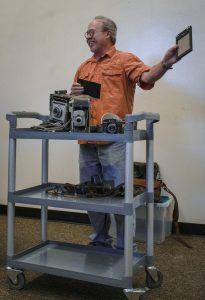Teaching Photography For the First Time
The fall semester is halfway over, the weather has finally cooled to tolerable temps, leaves are starting to turn, and, thus far, I have survived my first foray into teaching an Introduction to Digital Photography course at LeTourneau University. Having a full classroom of bright, eager-to-learn students certainly helps, as I navigate through building a course from scratch. Next semester will be easier; this semester’s students were forewarned that they were the guinea pigs. To the best of memory no one has ever taught photography at LETU.

Photography is how I managed to climb up the next rung at the Longview paper, where I had advanced from paperboy to working in the mailroom, hand-stuffing inserts into the papers, and on weekends helping one of the van drivers put papers in news racks. For a science project, I had faked a photograph of a UFO by stringing a model of the USS Enterprise from Star Trek — wings snapped off so it looked like a flying saucer — on fishing line. I laid down on the ground with my mom’s Kodak Brownie camera and took photographs that made it look as if a flying saucer was hovering over our house on South Twelfth Street.
Well, maybe if one ignored the perspective, which made the UFO look to be about five feet above the roofline — not technically possible given power lines. Or the fact the fishing line was faintly visible in the blurry 8×10 photographs I pasted on poster board. The fair was held at Kilgore College. Improbably, I won first place for ninth grade. The fellow who took my picture for the paper knew I worked there, since I hung around the place a lot.
“Are you interested in photography?” he asked, adding the department had a part-time opening. Sure, I was interested if it was going to get me out of the mailroom. Soon I was developing both roll film and 4×5 negatives, handed a twin-lens Rollieflex, given rudimentary instructions, and sent out on assignments when an adult photographer couldn’t make it. I got in trouble for using the battered company van instead of my Honda motorcycle, since at 15 I didn’t technically have a driver’s license for four-wheeled vehicles.
So that’s how it started. I earned a master’s majoring in photojournalism at the University of Texas and worked for a few papers as a shooter. I figured out being an editor — and eventually a publisher — paid more. Besides, newspapers in the 1980s of the size that would hire me usually only had one photographer. That person generally only left the post in a box or with a gold watch. I taught part-time for a decade at SFA while running The Daily Sentinel. The courses comprised everything except photography: reporting, editing, opinion writing, public affairs reporting, layout and design, even advertising. The same pattern held during my two stints at Kilgore College, since teaching legend O. Rufus Lovett held the photography slot. (My longtime friend has been a great help as I create this course.)

So twice a week I stand before a full class of 20 students and explain aperture and shutter speed, depth of field and other photographic concepts. We look at many, many photographs to demonstrate different types of photos — portraits, stop-action, landscapes, abstract images. I am slightly intimidated by how bright these students are. They catch on to the technical aspect very quickly, since man
y are engineering majors. I have acquired only a working knowledge of Photoshop and other Adobe products. As a photojournalist, I have no interest in manipulating an image beyond what could be done in an old-time film darkroom — cropping, dodging and burning, though now it’s by clicking a mouse or tapping some keys.
But if someone wants to further manipulate an image — take out a distracting sign in the background, for example — that is his or her business. I am fortunate that LETU provided an assistant for the course who is director of design for the university’s marketing department. Jeremiah knows far more than me about using image software, has been a great help, and is a fine photographer in his own right. As a result, I am learning a lot as well.
That is the best part of teaching this class. It is not only about what I can teach the students about photography — its history, theories of composition, genres and famous photographers of the past century-plus. It is what I can learn from them, the images they produce, and their faith as they each present a devotional at the beginning of class as one of their photo assignments. It has been worth the long hours spent in preparation. Besides, next semester will be easier.
Leave a reply
Fields marked with * are required











